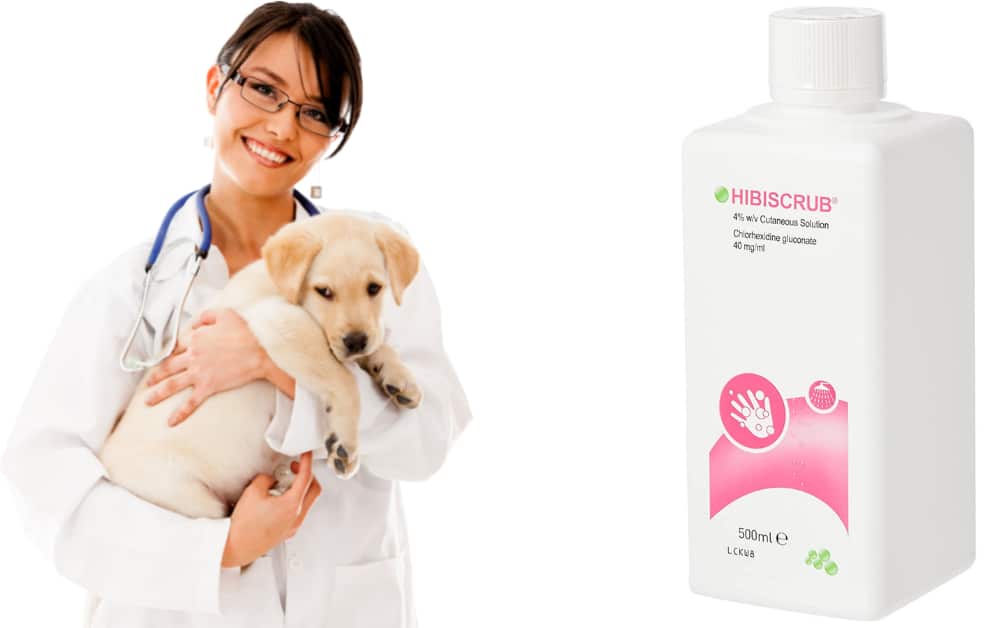Diarrhea and stomach upsets in dogs are common, but that doesn’t make them any less concerning. If your pup suddenly starts having tummy troubles, it’s natural to panic. That’s where Kaopectate, a well-known human medication, sometimes comes in. But wait—before you grab that bottle off the shelf and squirt it into your dog’s mouth, let’s talk about how to do this safely.
In this complete guide, we’re diving deep into the correct Kaopectate dosage for dogs, safety concerns, how to give it, what to watch out for, and more.
What is Kaopectate For Dogs?
Kaopectate for dogs is an over-the-counter (OTC) medication that most people associate with treating diarrhea, gas, and stomach upset in humans. It’s been around for decades and is often a go-to in household medicine cabinets. But pet owners might not know that it can sometimes be used to treat dogs experiencing similar gastrointestinal problems—with veterinary guidance.
Initially, Kaopectate contained kaolin and pectin. However, its formula changed in the early 2000s. Today, many versions contain bismuth subsalicylate (yes, the same active ingredient found in Pepto-Bismol). This change makes it crucial to understand what type of Kaopectate you’re using because some ingredients may be unsafe for dogs, particularly in high doses or over extended periods.
The key is using the correct form of Kaopectate—one that is bismuth-based and free of aspirin-related compounds that could harm your pet. It’s always best to use the product under a vet’s supervision to ensure the version you’re administering is dog-friendly.
Kaopectate Dosage For Dogs
The recommended Kaopectate dosage for dogs is 0.5 to 1.5 ml of liquid per pound (1.1 to 3.3 ml per kg) of body weight, or half of a 262 mg tablet for every 7.5 pounds (3.4 kg). This can be given 1 to 3 times per day, with or without food. Do not use Kaopectate for more than 48 hours, and contact your vet if your dog’s diarrhea hasn’t improved by then.
Liquid Kaopectate Dosage Chart For Dogs
| Dog Weight (lbs) | Dog Weight (kg) | Liquid Kaopectate Dosage |
|---|---|---|
| 5 lbs | 2.3 kg | 2.5 – 7.5 ml |
| 10 lbs | 4.5 kg | 5 – 15 ml |
| 15 lbs | 6.8 kg | 7.5 – 22.5 ml |
| 20 lbs | 9.1 kg | 10 – 30 ml |
| 25 lbs | 11.3 kg | 12.5 – 37.5 ml |
| 30 lbs | 13.6 kg | 15 – 45 ml |
| 40 lbs | 18.1 kg | 20 – 60 ml |
| 50 lbs | 22.7 kg | 25 – 75 ml |
| 60 lbs | 27.2 kg | 30 – 90 ml |
| 70 lbs | 31.8 kg | 35 – 105 ml |
| 80 lbs | 36.3 kg | 40 – 120 ml |
Tablet Kaopectate Dosage Chart For Dogs
| Dog Weight (lbs) | Dog Weight (kg) | Tablet Dosage (262 mg tablets) |
|---|---|---|
| 7.5 lbs | 3.4 kg | ½ tablet |
| 15 lbs | 6.8 kg | 1 tablet |
| 22.5 lbs | 10.2 kg | 1½ tablets |
| 30 lbs | 13.6 kg | 2 tablets |
| 37.5 lbs | 17 kg | 2½ tablets |
| 45 lbs | 20.4 kg | 3 tablets |
| 52.5 lbs | 23.8 kg | 3½ tablets |
| 60 lbs | 27.2 kg | 4 tablets |
| 67.5 lbs | 30.6 kg | 4½ tablets |
| 75 lbs | 34 kg | 5 tablets |
⚠️ Important: These are general dosage estimates. Always consult your veterinarian before giving Kaopectate to ensure it’s safe and appropriate for your dog’s specific condition.
Is Kaopectate for Dogs Safe?
Kaopectate is not FDA-approved for use in animals. However, it is sometimes used off-label by veterinarians, especially in cases where mild diarrhea doesn’t need more aggressive intervention.
That said, “off-label” doesn’t mean “unsafe.” It means it hasn’t gone through the formal FDA process for veterinary use. Vets may still recommend it, especially when they have experience dosing it correctly based on the dog’s weight, age, breed, and health status.
Many vets have used Kaopectate for years with good results, but they often caution pet owners to:
- Use it only short-term
- Avoid giving it to puppies, pregnant dogs, or those with chronic illnesses
- Monitor for side effects like black stool, vomiting, or lethargy
How Does Kaopectate Work in Dogs?
In canines, Kaopectate works by soothing the lining of the stomach and intestines, reducing inflammation, and helping solidify stool. The bismuth subsalicylate acts as an anti-inflammatory, antimicrobial, and mild antacid.
Here’s what happens when a dog ingests Kaopectate:
- Anti-inflammatory action: Helps calm irritated intestinal linings.
- Antibacterial effects: The bismuth component can kill certain bacteria that contribute to diarrhea.
- Binding effect: It can help slow down the intestines, leading to more solid stool.
However, this doesn’t mean it’s a cure-all. Kaopectate is a supportive treatment, not a solution to chronic issues. If the underlying problem is an infection, parasite, or toxin, this medicine won’t fix it. It may mask symptoms, but it won’t heal the root cause.
Active Ingredients and Their Role
Most modern versions of Kaopectate contain bismuth subsalicylate, though some may still include kaolin and pectin. It’s important to check the label before administering.
Here’s a breakdown of commonly found ingredients:
- Bismuth Subsalicylate – The main active ingredient. Provides anti-inflammatory, anti-secretory, and antimicrobial properties.
- Kaolin – A type of clay that helps absorb water and toxins in the gut.
- Pectin – A fiber source that works to bulk up stool and slow digestion.
Always double-check the formulation you have at home. Never use a version with aspirin derivatives without your vet’s green light. Dogs are sensitive to salicylates, which can cause ulcers, vomiting, and in some cases, even toxicity.
When You Should and Shouldn’t Use It
Use Kaopectate when:
- Your dog has mild, non-chronic diarrhea
- There’s no vomiting, blood in stool, or severe dehydration
- Your vet has ruled out parasites, viruses, or bacterial infections
- The dog is otherwise healthy and not on other medications that may interact
Avoid Kaopectate when:
- There’s persistent diarrhea lasting more than 48 hours
- Vomiting occurs with the diarrhea
- Your dog is on medications that may interact with bismuth or salicylates
- Your dog has known liver, kidney, or gastrointestinal issues
- There’s blood in the stool—this could indicate a serious problem
When in doubt? Always call your vet first. Even if the symptoms seem minor, you never want to gamble with your dog’s health.
Liquid vs Tablet Forms: What to Use
Liquid is usually preferred for dogs because:
- It’s easier to dose accurately.
- It can be mixed into food.
- It’s easier to administer with a syringe or dropper.
Tablet forms can be used, but it’s harder to adjust for precise weight-based dosing, and not all dogs are cooperative when it comes to pills. If you do use tablets, make sure they’re uncoated and free from extra human-targeted ingredients like caffeine or flavorings.
Side Effects and Warnings
Just like with any medication, Kaopectate isn’t without its risks. While most dogs tolerate the correct dose well, you should still watch for side effects that may indicate a bad reaction.
Common side effects may include:
- Black or tarry stools – Often harmless from bismuth but can mimic internal bleeding
- Constipation – Overcorrection of diarrhea may occur
- Nausea or vomiting – May indicate medication intolerance
- Lethargy – Could signal an adverse reaction
- Loss of appetite – May be due to taste or GI irritation
If symptoms persist >24 hours, stop the medication and contact your vet immediately.
Rare but serious risks:
- Ulcers
- Gastrointestinal bleeding
- Kidney damage
- Salicylate toxicity (especially in small canines)
How Often Should You Administer Kaopectate?
Kaopectate is typically given every 6 to 8 hours for no more than 48 hours unless otherwise directed by your vet.
If symptoms persist beyond two days, stop the treatment and consult your veterinarian immediately. Longer use may not only be ineffective but can lead to masking more serious conditions like:
- Parvovirus
- Intestinal obstructions
- Bacterial infections
Monitoring your furry friend closely while on Kaopectate is vital. Watch for changes in stool color (bismuth can turn it black), behavior, appetite, and energy levels.
Signs That Your Dog Needs Kaopectate
Kaopectate isn’t a miracle fix, but it can be highly effective for short-term relief of specific gastrointestinal issues. Recognizing the early symptoms that Kaopectate is designed to treat can help prevent minor problems from becoming major ones.
Here are signs your dog might benefit from Kaopectate:
- Mild diarrhea: Loose stools that occur occasionally but aren’t accompanied by blood or mucus
- Gurgling stomach: That watery, bubbly sound may indicate mild gastrointestinal upset
- Occasional vomiting: One-time vomiting with no blood or bile (though vet consultation is still advised)
- Flatulence and bloating: Dogs with frequent gas or discomfort may feel better with a GI-soothing agent
- Sporadic tummy discomfort: If your pup seems to be licking their lips often, pacing, or refusing food occasionally
But remember, not every canine showing these symptoms is a candidate for Kaopectate. Always ask yourself: Is this just a one-off, or is there a pattern here? If symptoms persist beyond 24–48 hours, the issue could be something more serious.
When to Call the Vet Instead
It’s tempting to self-treat, especially if the symptoms seem minor. But there are clear red flags that should have you dialing your vet immediately rather than reaching for Kaopectate:
- Blood in stool or vomit
- Vomiting lasting >12–24 hours
- Diarrhea lasting >48 hours
- Lethargy or unresponsiveness
- Signs of dehydration (sunken eyes, dry gums, loss of skin elasticity)
- Severe abdominal pain (whining, crying, protecting belly area)
- Pale gums (could indicate internal bleeding or shock)
If your dog is a puppy, senior, or has a pre-existing condition, it’s better not to administer anything without a vet’s approval. Time is often critical in pet emergencies. The wrong move—even with the best intentions—can make things worse.
How to Administer Kaopectate to Dogs
Administering medication to a dog isn’t always a walk in the park. Some pups will fight tooth and nail against anything that smells or tastes remotely medicinal. But don’t worry—here’s a step-by-step approach that works for most puppies when it comes to giving Kaopectate.
- Choose the Correct Form: As mentioned earlier, liquid Kaopectate is usually easier to manage. Ensure it’s bismuth subsalicylate-based and not containing xylitol or salicylates that could harm your furry friend.
- Measure the Dose Carefully: Use a syringe or dropper to measure out the correct dosage based on your dog’s weight. Double-check the measurement. Precision matters here.
- Secure Your Dog: Have your dog sit or lay down in a comfortable, non-slippery area. If your puppy is particularly squirmy, enlist the help of another person to gently hold them still.
- Lift the Lip and Insert the Syringe: Insert the syringe into the side of your dog’s mouth, between the cheek and teeth. Aim toward the back of the throat, but do not force it too deep.
- Slowly Administer: Depress the plunger slowly so your dog has time to swallow the liquid. If your pup resists or coughs, pause and let them calm down before continuing.
- Reward and Reassure: Immediately reward your furry friend with a treat or praise. This helps reduce future resistance and makes medicine time a more pleasant experience.
- Monitor: After giving Kaopectate, keep a close eye on your pup for any adverse reactions, changes in behavior, or worsening symptoms.
Pro tip: If your dog resists the syringe method, try mixing the medication with a small amount of wet food or a spoonful of plain, non-fat yogurt. Just make sure they eat the whole portion.
Tips for Picky Dogs
Let’s face it—not all canines are fans of weird-tasting liquids. If your dog turns up their nose at Kaopectate, here are a few tricks:
- Use a flavored syringe: Some pet stores sell meat-flavored syringes or droppers that can make the experience a bit tastier.
- Wrap in a “meatball”: If you have the tablet form, crush it and mix it into a tiny ball of wet dog food or soft cheese.
- Disguise it with strong smells: Canines rely heavily on smell, so masking the medicine with something like liver paste or peanut butter (xylitol-free) can do wonders.
- Keep it small: Mix the dose into a very small amount of food. That way, you know your dog got the full amount without leaving leftovers in the bowl.
Training and patience are key here. If your dog associates the experience with stress or punishment, it’ll only get harder next time. Keep it light and reward-driven.
Drug Interactions to Watch Out For
Kaopectate may interact with:
- Aspirin/NSAIDs – Increased bleeding risk
- Steroids – Higher GI irritation potential
- Antibiotics – Reduced absorption
- Diuretics – May worsen electrolyte imbalances
Always disclose all medications/supplements your dog takes.
Alternatives to Kaopectate for Dogs
Natural Remedies
For mild cases, consider:
- Pumpkin puree (plain, not pie mix)
- Bland diet (boiled chicken + rice)
- Slippery elm (GI-soothing herb)
- Probiotics (gut flora support)
Other OTC Options
Vet-approved alternatives:
- Pepto-Bismol (same salicylate risks)
- Imodium (dangerous in some breeds)
- Pedialyte (hydration support)
- Tylosin (prescription antibiotic for IBD)
Critical reminder: Never use human medications without veterinary guidance. What helps humans may harm dogs.
You May Also Like To Read:
FAQs
Can I give Kaopectate to my puppy?
It’s generally not recommended to give Kaopectate to puppies under 6 months old unless specifically directed by a vet. Puppies are more sensitive to medications and at higher risk for dehydration.
How quickly does Kaopectate work in dogs?
Most dogs show improvement within 6 to 12 hours of the first dose. If there’s no change after 24 hours or symptoms worsen, stop the medication and contact your vet.
Can I give my dog Kaopectate if they are on other medications?
Maybe—but it depends on the medications. Kaopectate can interact with NSAIDs, steroids, and certain antibiotics. Always check with your vet before combining treatments.
Is it safe to use Kaopectate long-term for chronic issues?
No. Kaopectate is intended for short-term relief only. Chronic digestive issues need a proper diagnosis and long-term treatment plan from your vet.
What do I do if I accidentally gave my dog too much Kaopectate?
Call your vet or an emergency pet poison hotline immediately. Signs of overdose include vomiting, black tarry stools, tremors, or difficulty walking.
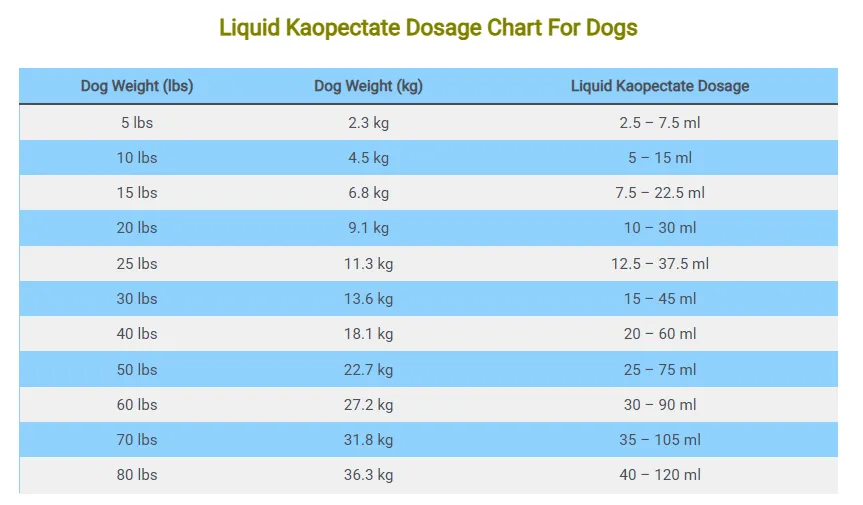
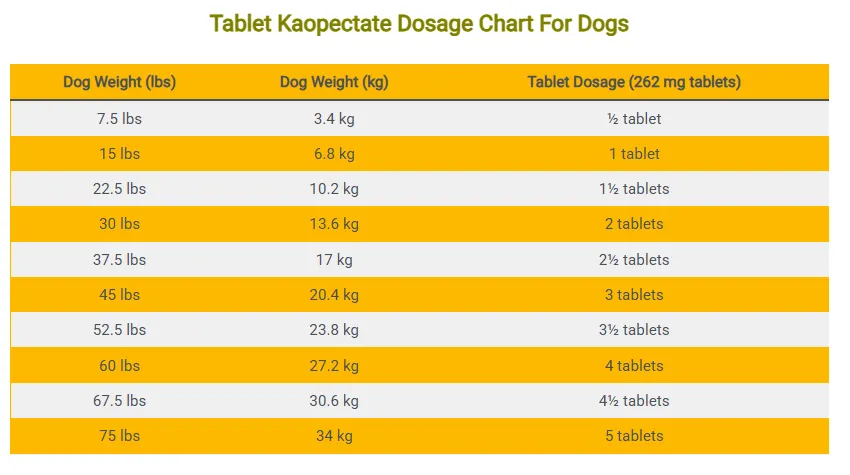


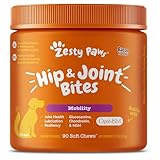




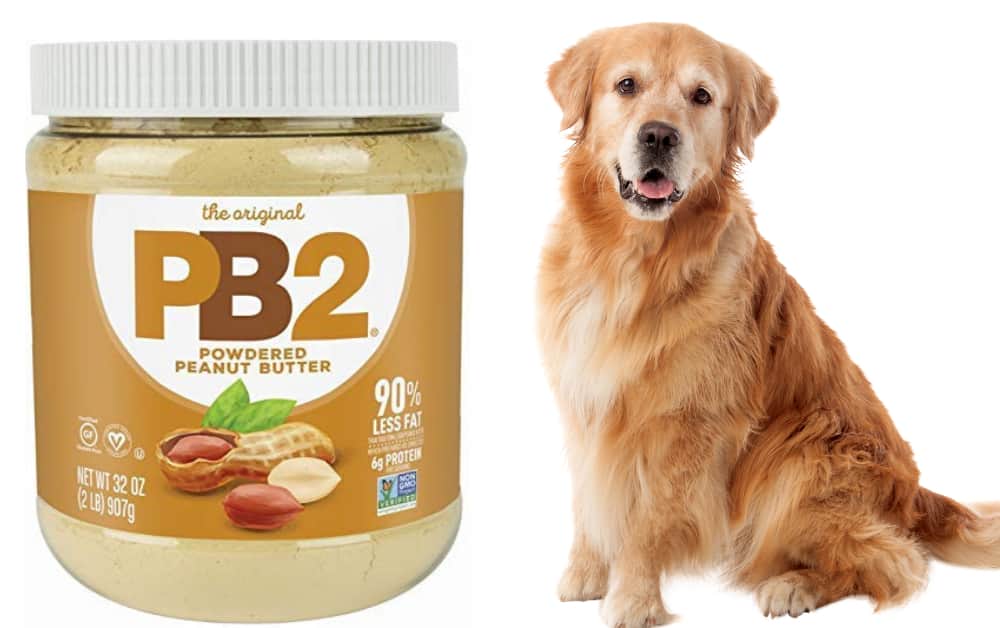

![Can Dogs Eat Blood? 7 Side Effects [Expert Opinion]](https://petskor.com/wp-content/uploads/2022/04/Webp.net-resizeimage-12.jpg)
